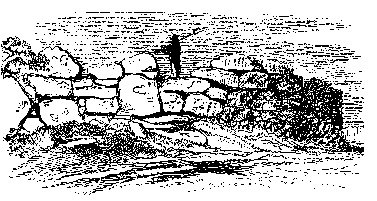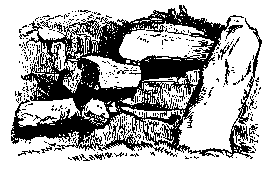Chapter 5: Coill Beag to Inis Uí Chuinn
- Parish of Cairrgín
- Cahergal Fort
- Killursa
- Coill Bheag to Inis Uí Chuinn
- [no title]
- Rosserilly
- Shrule
Return to table of contents
Refer to Map
The great uncemented Cyclopean stone fort to which this extract
refers still encircles the brow of the little island, as shown in the
following illustration, but the scrubby brushwood around it partially
obscures the masonry, which stands over a deep trench or fosse, that
must have rendered its capture a matter of much difficulty before the
general introduction of fire-arms. In all probability it served like a
crannóg to guard Cairrgín
 Castle, or as a safe refuge for the persons and valuables of its
inmates, or those of the surrounding country.There can, however, be no
doubt that this structure belongs to the days of the unmortared dúns,
cahers, and cashels long prior to the date of the Anglo-Norman
invasion.The walls average six feet thick, and are still ten and a
half feet high; but the stones of which they are composed, owing in all
probability to the fact of their having been carried from the
neighbouring mainland, are of comparatively small size.They enclose
an oval space of one hundred and forty-four yards in circumference;
and the doorway is on the east or land side, where the ditch is level
to afford means of access.The present name of the island on the
Ordnance Map is Ilaun Carbery, because a fanatic named Carbery lived
for many years during the eighteenth century in a hut he built for
himself within the enclosure.
Castle, or as a safe refuge for the persons and valuables of its
inmates, or those of the surrounding country.There can, however, be no
doubt that this structure belongs to the days of the unmortared dúns,
cahers, and cashels long prior to the date of the Anglo-Norman
invasion.The walls average six feet thick, and are still ten and a
half feet high; but the stones of which they are composed, owing in all
probability to the fact of their having been carried from the
neighbouring mainland, are of comparatively small size.They enclose
an oval space of one hundred and forty-four yards in circumference;
and the doorway is on the east or land side, where the ditch is level
to afford means of access.The present name of the island on the
Ordnance Map is Ilaun Carbery, because a fanatic named Carbery lived
for many years during the eighteenth century in a hut he built for
himself within the enclosure.
To the foregoing notice of the depredations upon Loch Coirib in early times may be added the following, A.D. 929: "The Danes of Limerick took possession of Loch Oirbsen, and pillaged its islands." A.D. 1061 the O Flahertys of the adjoining territory of Magh Seóla, already referred to above took possession of Loch Coirib, and expelled Aodh O Conor; and in 1224, after the death of Cathal Crobhdearg, the red-handed son of King Turloch, and during the contentions between the O Conors of Connacht, Aodh, the son of Cathal, compelled the O Flahertys to deliver up this island, as referred to in the foregoing extract.
In 1233 Felim O Conor, King of Connacht "demolished the castles of Kirk Island, Galway, Hag Island, and Dún na mBan." Again, "in 1256 Walter De Burgo, Lord of Connacht, and first Earl of Ulster, marched against Roderick O Flaherty, plundered the territories of Gnó Mór and Gnó Beg, west of Loch Orbsen, and took possession of the lake, its islands and castles.These he fortified, and by that means considerably increased the power of the English in Connacht." In all probability it was at this period, and from thence up to 1450, that the great majority of the De Burgo Castles in this district were built or remodelled.
About two miles east of the lake, in this parish, stands Cathair Geal, or "Whitefort," one of the finest specimens of ancient military architecture on the mainland of Ireland, and which can easily be reached by the roads leading from Coill Beag or Claoideach to Headford.From its colour it gives its English name to the townland, as, for similar reasons, we meet with the names of Roundfort and Darkfort, etc., in other localities.
The magnificent circular Cyclopean building, a portion of the external face of which is well shown in the subjoined illustration, encloses a space of one hundred and thirty-seven feet in diameter; and its massive walls of unhewn stone, of a whitish hue from the lichens covering them, are nine feet four inches thick, and, although lowered in many places, still average seven feet seven inches high.

The entrance on the south-eastern side, over the road leading to a farm house, is seven feet six inches wide; its external jambs, measuring five feet eight inches over ground, are each five feet broad, and twenty-one inches thick.Inside, on the south-east, is a fight of three massive steps, figured on the next page, which probably led to a parapet, as at Stague fort, in Kerry.Within the enclosure there are the remains of several intersecting walls; but, as the space is grass-grown, it is difficult to say whether they are the ruins of Clocháns,[fn42-1] of which there is a tradition.
